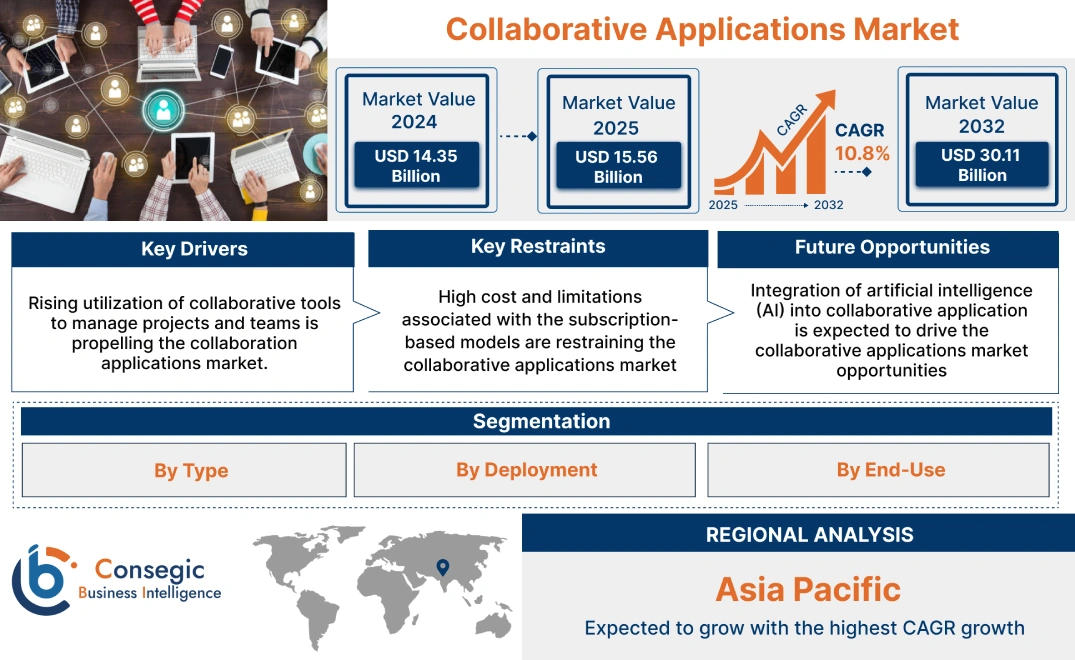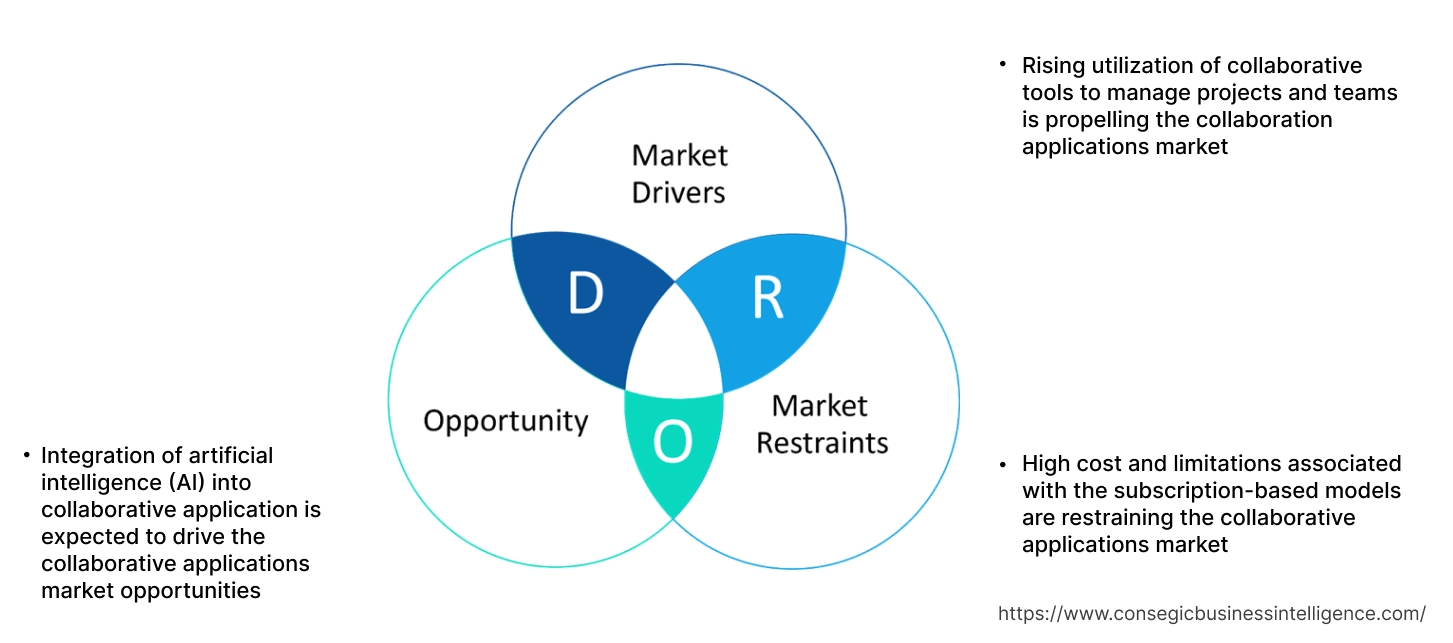Collaborative Applications Market Size:
Collaborative Applications Market Size is estimated to reach over USD 30.11 Billion by 2032 from a value of USD 14.35 Billion in 2024 and is projected to grow by USD 15.56 Billion in 2025, growing at a CAGR of 10.8% from 2025 to 2032.
Collaborative Applications Market Scope & Overview:
Collaborative applications, also called team collaborative solutions, are software tools that create a virtual workspace for multiple users, enabling real-time interaction regardless of their physical location. These applications offer features such as instant messaging, video conferencing, and voice chats to ensure smooth communication. Furthermore, they enhance task management by allowing users to set deadlines, track progress, assign tasks, and ultimately improve efficiency and organize operations.
Key Drivers:
Growing digital transformation across various industries is driving the collaborative applications market expansion
The expanding trend of digital transformation across various industries is propelling the market. Organizations are increasingly investing in digital tools and platforms to improve operational efficiency, enhance customer experience, and gain a competitive edge. Collaboration applications are a crucial part of these digital transformation strategies, as they enable seamless communication and collaboration across different departments and geographies. This trend is particularly prominent in several industry verticals, such as BFSI, healthcare, and IT & telecommunications, where real-time communication and collaboration are critical.
- For instance, Microsoft Teams, a cloud-based collaborative software by Microsoft Corporation, provides real-time features such as accessibility, meeting capabilities, integration with Microsoft 365, and file sharing and storage.
Thus, according to the collaborative applications market analysis, the growing digital transformation across various industries is driving the collaborative applications market size.
Key Restraints:
High development costs of subscription-based models are affecting the collaborative applications market demand
A subscription-based model provides periodic access to a service (daily, weekly, annually, and others). However, this model faces several challenges that limit the market demand. These include the risk of customer churn, high long-term costs for users, reliance on internet connectivity, and delayed return on investment (ROI) for providers. Additional drawbacks such as longer payback periods, complex pricing strategies, heightened competition, and market saturation further hinder its growth. Therefore, the aforementioned factors would further impact the collaborative applications market.
Future Opportunities :
Increasing integration of artificial intelligence (AI) and machine learning (ML) is expected to create potential growth for collaborative applications market opportunities
AI and ML can enhance the functionality of collaboration applications by automating tasks, providing insights, and improving user experience through features such as predictive text, smart scheduling, and real-time translation. The rise of AI in collaboration applications signifies a shift where several tools are integrated into collaboration applications to enhance AI’s capabilities for better coordination and teamwork among an individual and teams. Moreover, the integration of AI offers various features such as mind mapping, diagramming, automation, instant presentations, auto clustering of notes, and others, which are rapidly expanding and offering solutions for various tasks.
- For instance, in August 2024, ViewSonic Corporation introduced TeamOne, an AI-powered collaboration software. TeamOne enables users to co-create in real-time for improved efficiency, visually manage complex tasks, streamline workflows, and generally enhance the collaborative experience. This strategic innovation is expected to boost the growth of the collaborative applications market share.
Thus, based on the above collaborative applications market analysis, the above factors are expected to drive the collaborative applications market opportunities.
Collaborative Applications Market Segmental Analysis :
By Type:
Based on type, the collaborative applications market is segmented into conferencing software and communication and coordination software.
Trends in the type:
- The continuous innovation in software features and the growing trend of outsourcing IT services will continue to propel collaborative applications.
- Project management software is another crucial component within the software segment. Tools such as Trello, Jira, and Basecamp help organizations manage tasks, track progress, and ensure timely completion of projects. The increasing complexity of business operations and the need for effective project management are driving the adoption of these tools, further driving the collaborative applications market growth.
- Thus, based on the above analysis, these factors are driving the collaborative applications market demand.
The conferencing software segment accounted for the largest revenue in the year 2024.
- Businesses are increasingly relying on video conferencing tools to maintain seamless operations and communication among geographically dispersed teams.
- Organizations are increasingly focusing on improving their IT infrastructure and investing in cloud-based solutions, which not only support virtual communication but also offer scalability, flexibility, and ease of deployment.
- The continuous evolution of technologies such as artificial intelligence (AI) and machine learning (ML) is set to enhance video conferencing functionalities, offering features such as real-time language translation, facial recognition, and intelligent noise cancellation.
- Thus, based on the above analysis, these factors are further driving the collaborative applications market growth and trends.
The communication and coordination software segment is anticipated to register the fastest CAGR during the forecast period.
- Communication and coordination software primarily facilitates asynchronous exchanges, such as messaging, file sharing, and project planning.
- This type of software offers several advantages, including improved internal communication, enhanced coordination, increased efficiency, and better collaboration.
- For instance, in 2024, Hubspot unveiled Breeze, an AI-powered communication and coordination software. As part of Hubspot's comprehensive AI suite, Breeze aims to boost team productivity, automate manual tasks, and provide actionable insights. The key features include an integrated AI for a unified platform, automation of repetitive tasks, instant insights, and advanced personalization.
- Thus, the above developments are expected to drive the collaborative applications market share and trends during the forecast period.
By Deployment:
Based on deployment, the collaborative applications market is segmented into cloud and on premise.
Trends in the deployment:
- The ongoing advancements in cloud technology, coupled with the increasing focus on data security and compliance, will transform the future landscape of deployment modes in the collaboration applications market.
- Hybrid deployment models are also gaining traction, offering a blend of on-premises and cloud-based solutions. This approach allows organizations to leverage the benefits of both deployment modes.
- The above analysis and factors are anticipated to further drive the collaborative applications market trends and demand during the forecast period.
The cloud segment accounted for the largest revenue share in the year 2024 and it is expected to register the highest CAGR during the forecast period.
- The cloud deployment model allows organizations to access collaboration tools from anywhere with an internet connection, making it ideal for remote and hybrid work environments.
- Additionally, cloud-based solutions often feature regular updates and maintenance, reducing the burden on internal IT teams.
- Cloud-based tools offer organizations a cost-effective way to access advanced collaboration features without significant upfront investment.
- For instance, Slack is a software-as-a-service (SaaS) messaging and collaboration platform that functions as a virtual workspace hub. Its integrated Slack AI suite of generative AI tools helps users quickly find information. Additionally, Slack provides features such as direct messaging, voice calls, channels, video calls, and integration with other productivity tools.
- Thus, based on the above analysis, these factors would further supplement the collaborative applications market trends.
By End Use:
Based on end use, the collaborative applications market is segmented into IT and telecommunication, retail & e-commerce, education, BFSI, healthcare, logistics and transportation, government and defense, media and entertainment, and others.
Trends in the end use:
- The education sector has seen a significant increase in the adoption of collaboration applications, driven by the rise of remote learning and digital classrooms. Educational institutions use these tools to facilitate virtual classes, enable real-time communication between students and teachers, and manage administrative tasks.
- Government organizations are also significant users of collaboration applications. These tools help government agencies manage projects, coordinate responses to emergencies, and communicate with the public.
- Thus, the above factors are driving the global market.
The IT and telecommunication segment accounted for the largest revenue share of 26.82% in the year 2024.
- IT companies use collaboration tools to manage projects, coordinate teams, and streamline workflows.
- Telecommunications companies leverage these tools to ensure seamless communication across their vast networks. The integration of advanced technologies like AI and ML in collaboration applications enhances their functionality, making them indispensable in this sector.
- For instance, IBM Corporation uses its proprietary collaborative application, IBM Connections, to help individuals communicate, collaborate, and build stronger relationships. IBM Connections offers various collaboration tools like wikis, communities, and blogs to enhance team communication.
- Thus, the above factors and developments are driving the global market.
The BFSI segment is anticipated to register the fastest CAGR during the forecast period.
- The BFSI sector is one of the largest adopters of collaboration applications, driven by the need for secure, efficient communication and collaboration.
- Financial institutions require robust collaboration tools to manage complex workflows, ensure compliance, and enhance customer service.
- The integration of collaboration applications with other financial systems (CRM and ERP) further enhances their effectiveness in this sector.
- For instance, Troop Messenger offers a workplace collaboration tool for utilization in the BFSI sector. The workplace collaboration tool enables BFSI firms to connect with customers in real time along with securing improved collaboration between cross departments.
- Thus, based on the above analysis, these developments are expected to drive the global
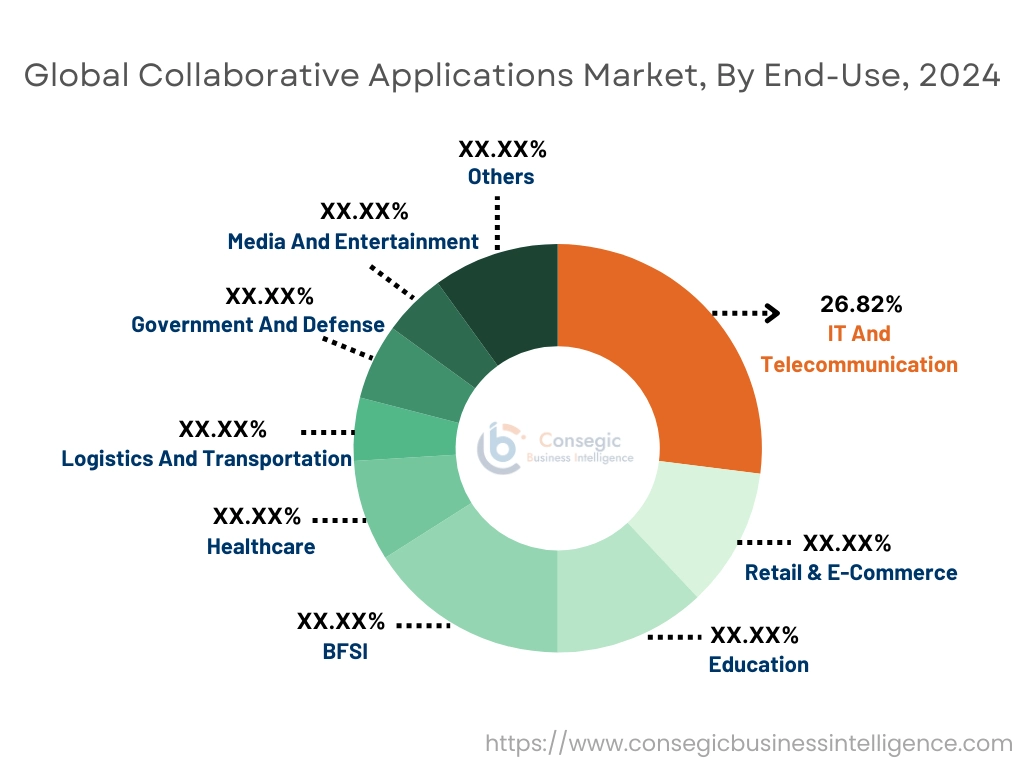
Regional Analysis:
The global market has been classified by region into North America, Europe, Asia-Pacific, Middle East & Africa, and Latin America.
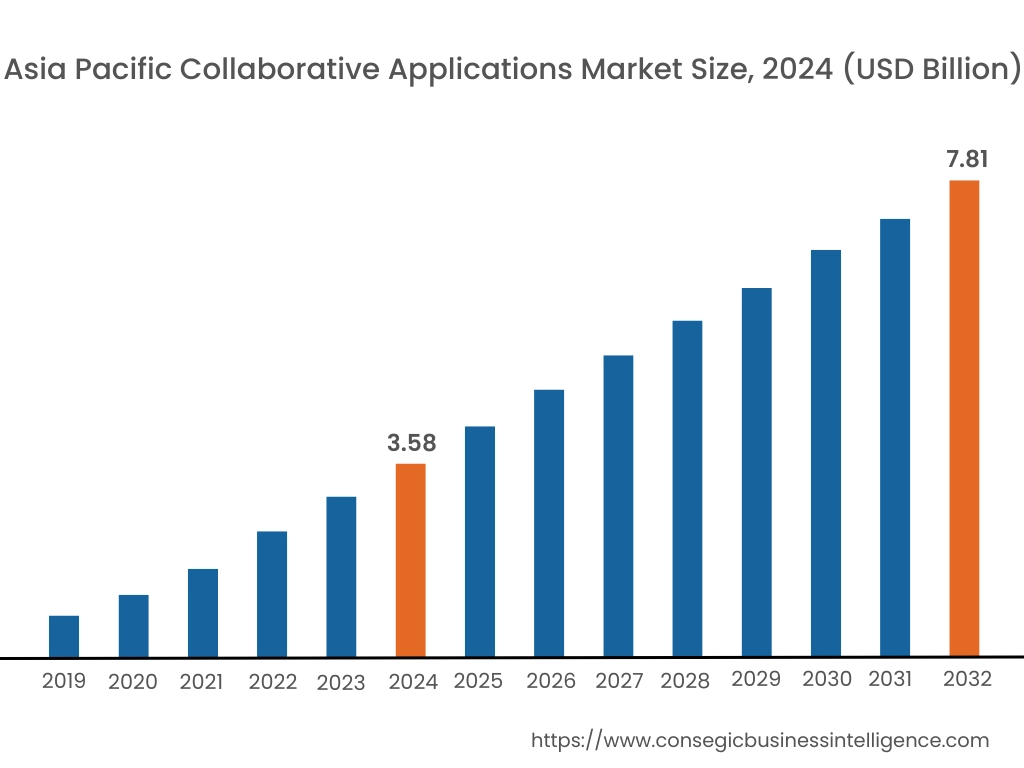
Asia Pacific collaborative applications market expansion is estimated to reach over USD 7.81 billion by 2032 from a value of USD 3.58 billion in 2024 and is projected to grow by USD 3.90 billion in 2025. Out of this, the China market accounted for the maximum revenue split of 31.53%. The regional growth can be attributed to rapid digitalization, growing IT infrastructure, and the increasing adoption of remote work practices in countries like China, India, Japan, and South Korea among others. Additionally, the rising development of BFSI and telecom enterprises is further accelerating the regional market expansion. These factors would further drive the regional collaborative applications market during the forecast period.
- For instance, Atlassian Corporation Plc, an Australian company, provides its Atlassian Cloud platform for real-time collaboration. This platform offers features like real-time interaction, interactive tool experiences, improved collaboration, and automated workflows to enhance user alignment. These benefits are significantly driving the demand for collaborative applications in the Asia-Pacific region.
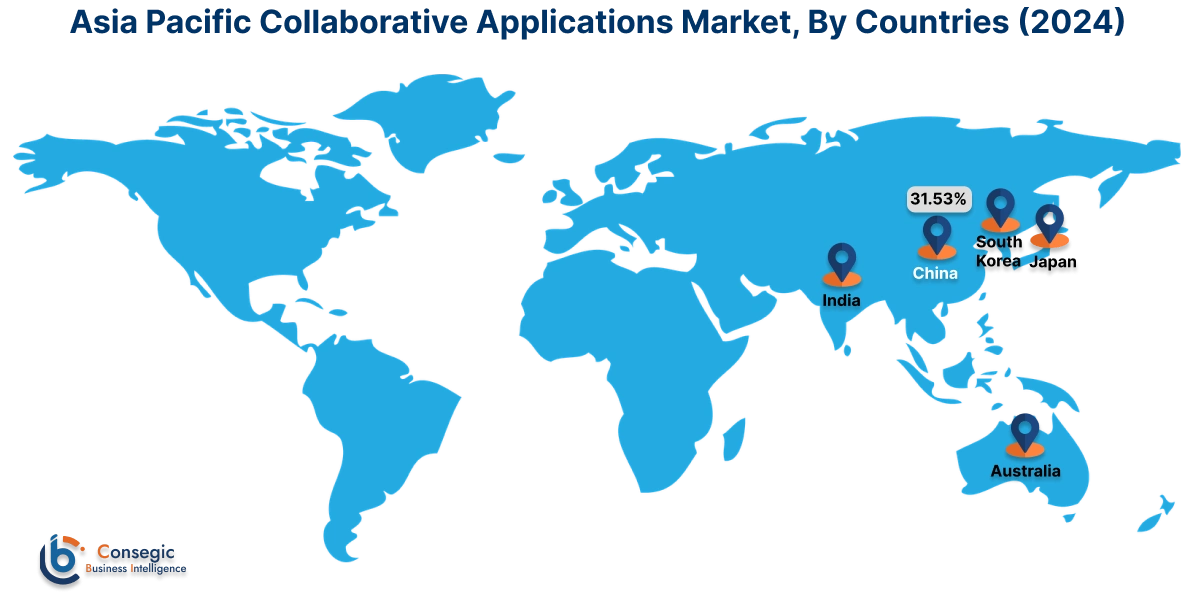
North American market is estimated to reach over USD 11.71 billion by 2032 from a value of USD 5.59 billion in 2024 and is projected to grow by USD 6.06 billion in 2025. North America is expected to hold a significant share of the market, driven by the presence of major technology companies, a highly developed IT infrastructure, and the widespread adoption of remote work practices. Further, the region's strong emphasis on innovation and technological advancements has fostered a favorable environment for the growth of video conferencing solutions. These factors would further drive the regional market during the forecast period.
- For instance, Zoom, a U.S.-based provider of collaborative solutions, reported a total revenue of USD 4,527 million for fiscal year 2024, representing a 3.1% year-over-year increase. This growth indicates significant market development in the North American region.
Additionally, according to the analysis, the collaborative applications industry in Europe is expected to witness significant development during the forecast period. The region's strong focus on innovation, coupled with robust digital infrastructure and high internet penetration rates, supports the adoption of collaboration tools.
Additionally, countries in Latin America are witnessing a surge in demand for video conferencing solutions, fueled by a growing population of tech-proficient consumers and enterprises seeking to enhance operational efficiency. Further, as businesses across the Middle East & Africa region continue to prioritize digital initiatives, the market is prepared for sustained growth, with several opportunities for vendors to tailor solutions to meet regional needs and preferences. These factors are driving the regional collaborative applications market size and share.
Top Key Players and Market Share Insights:
The global collaborative applications market is highly competitive with major players providing solutions to the national and international markets. Key players are adopting several strategies in research and development (R&D), product innovation, and end-user launches to hold a strong position in the market. Key players in the collaborative applications industry include-
- Microsoft Corporation (U.S.)
- Zoom Video Communications, Inc. (U.S.)
- Cisco Systems, Inc. (U.S.)
- Adobe Inc. (U.S.)
- Cisco Systems, Inc. (U.S.)
- Atlassian Corporation Plc (Australia)
- Google LLC (U.S.)
- Salesforce Inc. (U.S.)
- Asana Inc. (U.S.)
- Zoho Corporation (India)
Recent Industry Developments :
Product Launch:
- In October 2024, Miro has launched an AI-driven innovation workspace, a collaborative tool aimed at enhancing product design and innovation. This tool offers features that seamlessly integrate into existing workflows, making them more interactive, engaging, and inclusive.
Collaborative Applications Market Report Insights:
| Report Attributes | Report Details |
| Study Timeline | 2019-2032 |
| Market Size in 2032 | USD 30.11 Billion |
| CAGR (2025-2032) | 10.8% |
| By Type |
|
| By Deployment |
|
| By End Use |
|
| By Region |
|
| Key Players |
|
| North America | U.S. Canada Mexico |
| Europe | U.K. Germany France Spain Italy Russia Benelux Rest of Europe |
| APAC | China South Korea Japan India Australia ASEAN Rest of Asia-Pacific |
| Middle East and Africa | GCC Turkey South Africa Rest of MEA |
| LATAM | Brazil Argentina Chile Rest of LATAM |
| Report Coverage |
|
Key Questions Answered in the Report
How big is the collaborative applications market? +
The collaborative applications market was valued at USD 14.35 Billion in 2024 and is projected to grow to USD 30.11 Billion by 2032.
Which is the fastest-growing region in the collaborative applications market? +
Asia-Pacific is the region experiencing the most rapid growth in the collaborative applications market.
What specific segmentation details are covered in the collaborative applications market report? +
The collaborative applications market report includes specific segmentation details for type, deployment, end-use, and region.
Who are the major players in the collaborative applications market? +
The key participants in the collaborative applications market are Google LLC (U.S.), Microsoft Corporation (U.S.), Zoom Video Communications, Inc. (U.S.), Cisco Systems, Inc. (U.S.), Adobe Inc. (U.S.), Cisco Systems, Inc. (U.S.), Slack Technologies, LLC (U.S.), Atlassian Corporation Plc (Australia), Salesforce Inc. (U.S.), Asana Inc. (U.S.), Zoho Corporation (U.S.) and others.
